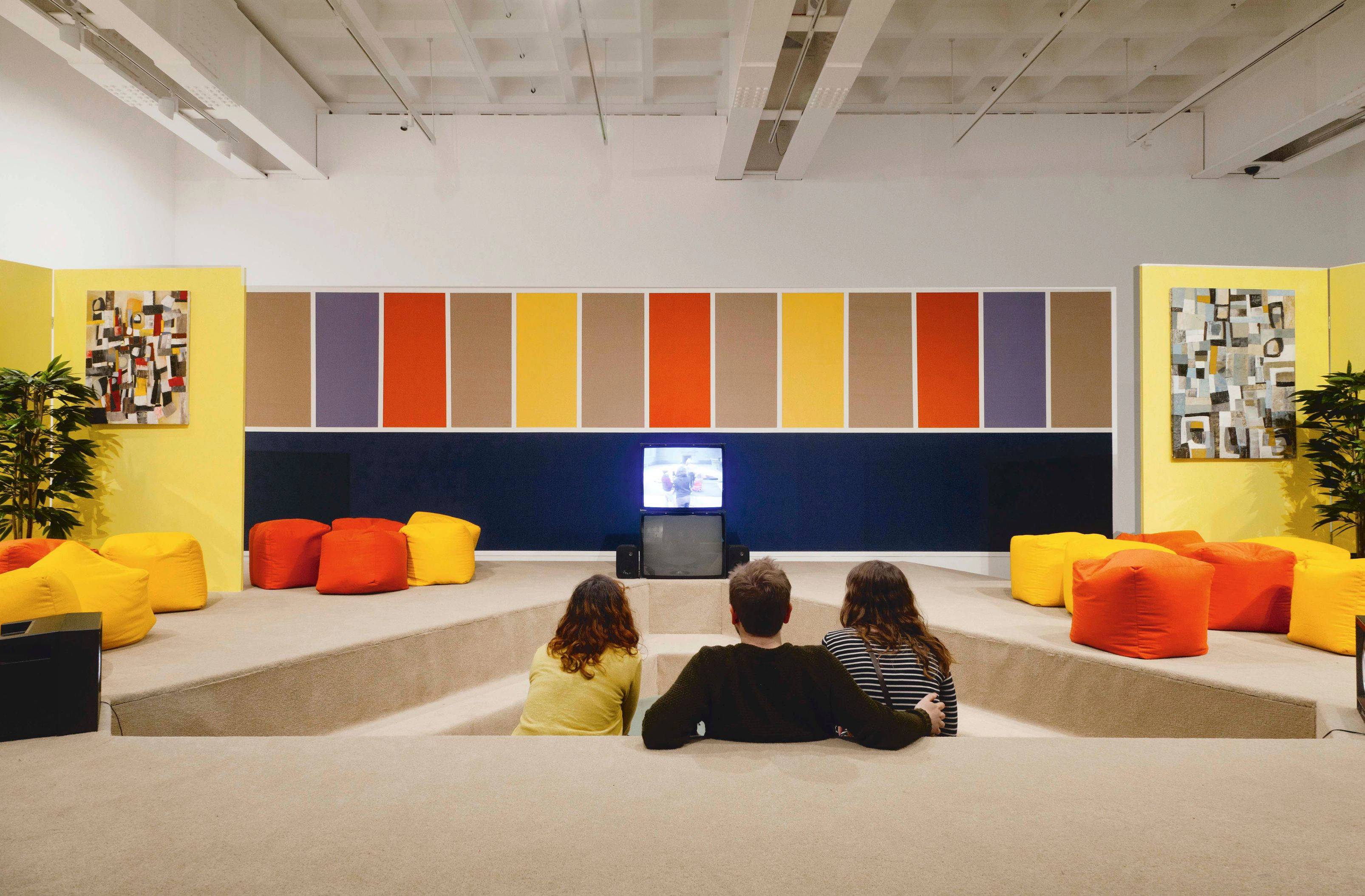
Open Forum, 2012, mixed-media installation (detail), ‘Rise Early, Be Industrious’, Arnolfini, Bristol
Tags: Anchor Stone BlocksArt and EnvironmentBankingBeehivesBritish Empire ExhibitionChance and ChoiceChickensColonialismCommons EnclosureCommonwealCommunesCommunity Arts MovementCruikshank, GeorgeDavis, Andrew JacksonDebtFactoryFeminismFeudalismFord, HenryFourier, CharlesFox, Kate & Maggie (the Fox sisters)Fröbel, FriedrichGamesKeynes, John MaynardKibbo KiftLines and GridsMilton KeynesModern SpiritualismNew AgeNew GamesNew TownsOwen, RobertPilgrim’s Progress, ThePolitical SatirePost-FordismRegenerationRepublic of ChildrenRevolutionSummerlandSwedenborg, EmanuelTelevisionUtopiaWomen’s Liberation
‘Rise Early, Be Industrious’, 2012–13
solo exhibition at MK Gallery (Milton Keynes), Arnolfini (Bristol) and CCA (Glasgow)
‘Rise Early, Be Industrious’ traces connections between several of my projects, which focus on historical and contemporary forms of education and its relation to the so-called Protestant work ethic, as famously described by sociologist Max Weber. Drawing on social history, the series of five ‘period rooms’ that make up this solo exhibition explore different educational models to emerge in the industrial and post-industrial eras – starting with the religious pulpit, and ranging from world fairs to television and Google. The installations look at opposing ideas about the purpose of education, training for the workplace versus education as an emancipatory practice. With a strong architectural dimension – involving the fabrication of platforms and models and a deliberate emphasis on play and game-like structures – the exhibition invited visitors to participate and ‘perform’, while considering how social roles and models of society have been constructed over the last few hundred years.
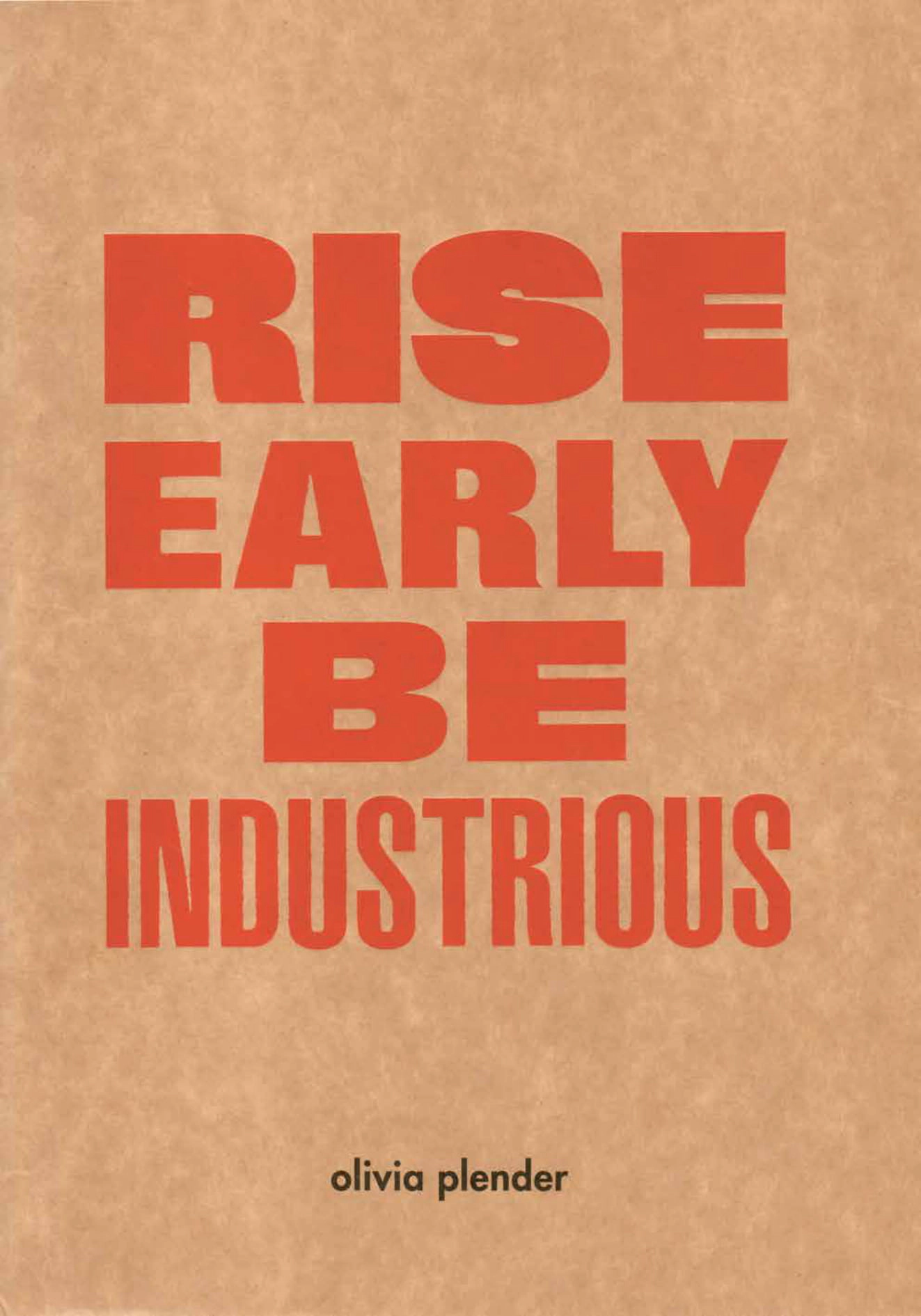
Rise Early, Be Industrious, 2016
catalogue/artist’s book, front cover, published by Sternberg Press
Exhibition catalogue/artist’s book published by Sternberg Press (2016), with essays by Maeve Connolly, Angus Cameron, Lars Bang Larsen and Tirdad Zolghadr. Edited by Olivia Plender and Gerrie van Noord.
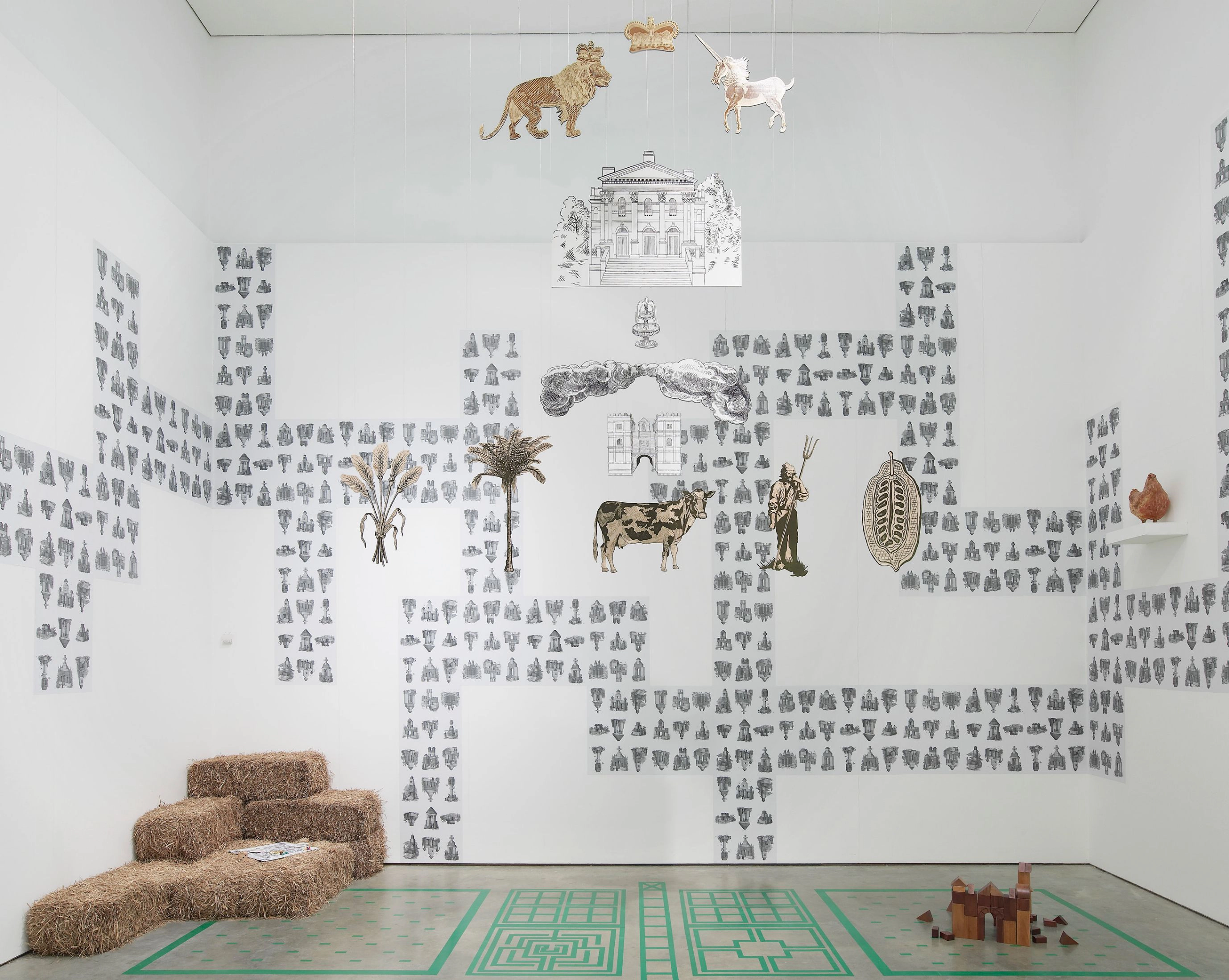
Words and Laws (whose shoulder to which wheel?), 2012, mixed-media installation, ‘Rise Early, Be Industrious’, MK Gallery, Milton Keynes
Words and Laws (whose shoulder to which wheel?), 2012, mixed-media installation
A collection of printed material, games encouraging participation, objects and posters, which reveal my interest in the history of popular printing and political satire. The installation focuses on how we learn social roles and includes various allegorical objects, resembling enlarged pieces from a board game.
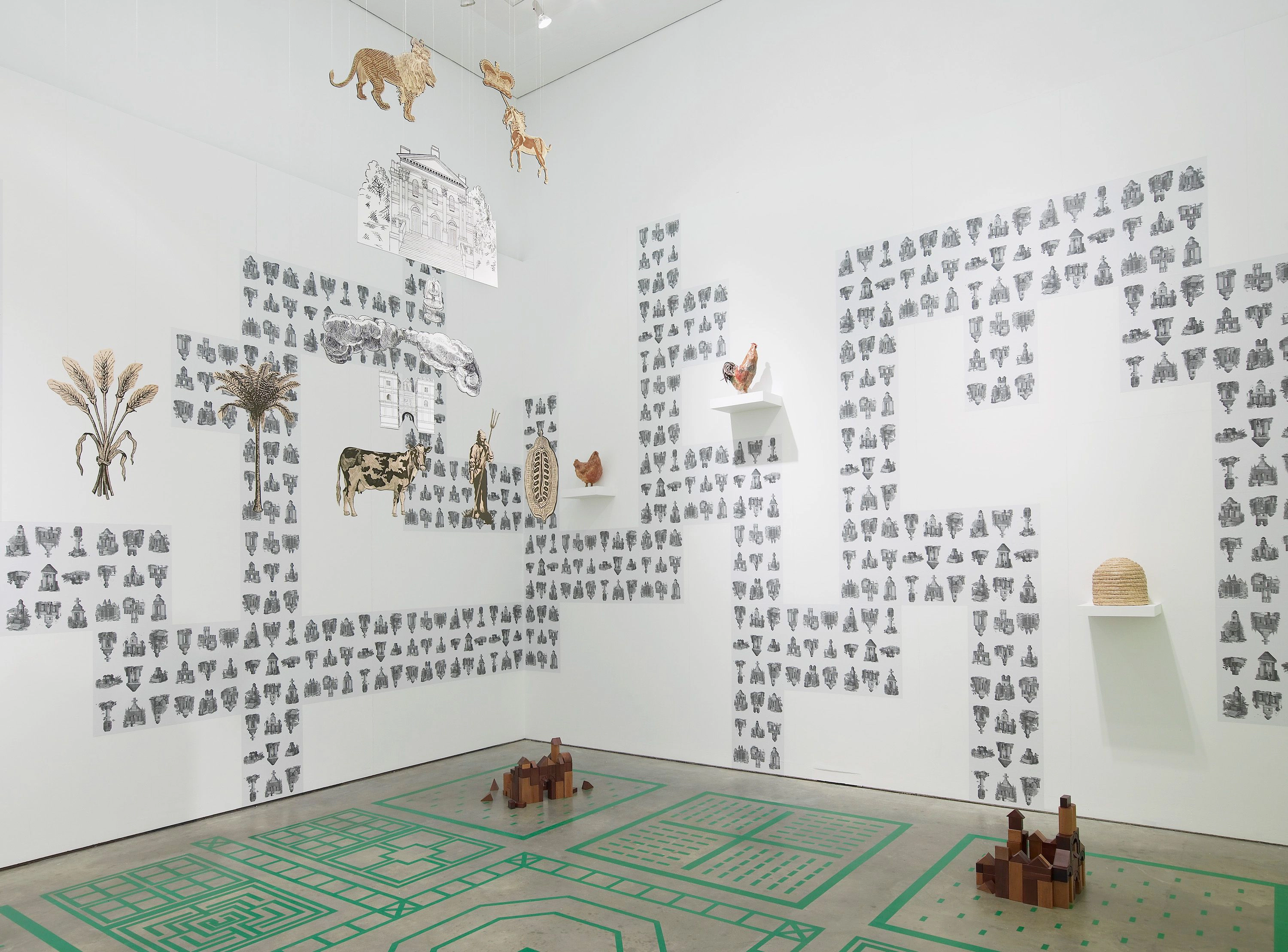
Words and Laws (whose shoulder to which wheel?), 2012, mixed-media installation, ‘Rise Early, Be Industrious’, MK Gallery, Milton Keynes
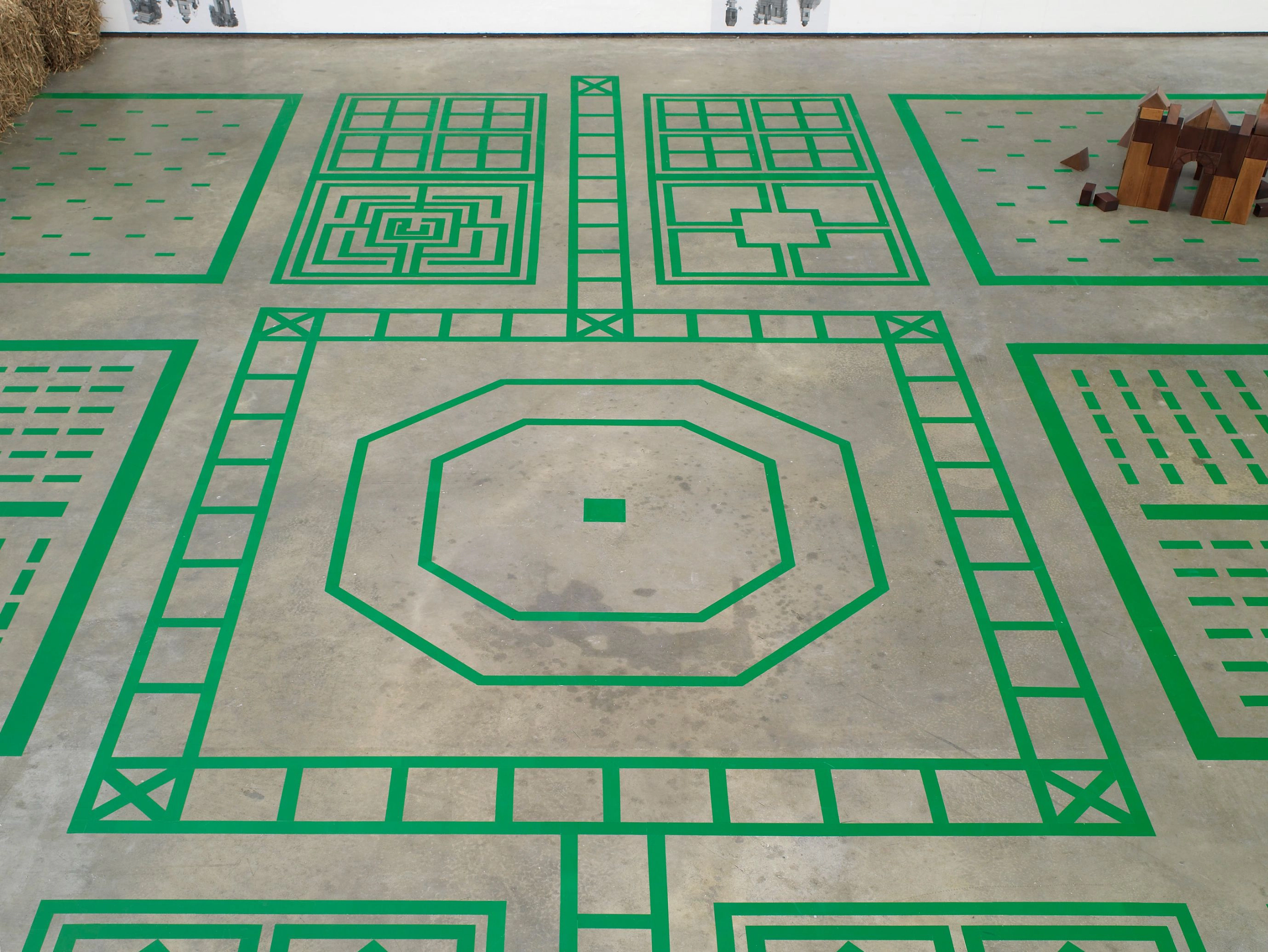
Hortus Conclusus (Enclosed Garden) (detail), 2012, green tape floor piece ‘Rise Early, Be Industrious’, MK Gallery, Milton Keynes
Hortus Conclusus (Enclosed Garden), 2012
suspended mobile, floor piece of green tape
In the mobile that makes up half of Hortus Conclusus (Enclosed Garden), the hierarchy of British society is presented as a pyramid. At the top sit the crown, lion and unicorn (which can be found on British passports), followed by a manor house. Below, separated from this paradise by a heavy gate, are human labour and raw materials, extracted from both Britain and the colonies, upon which the pyramid stands. The green lines on the floor follow the plans of a grand country house garden.
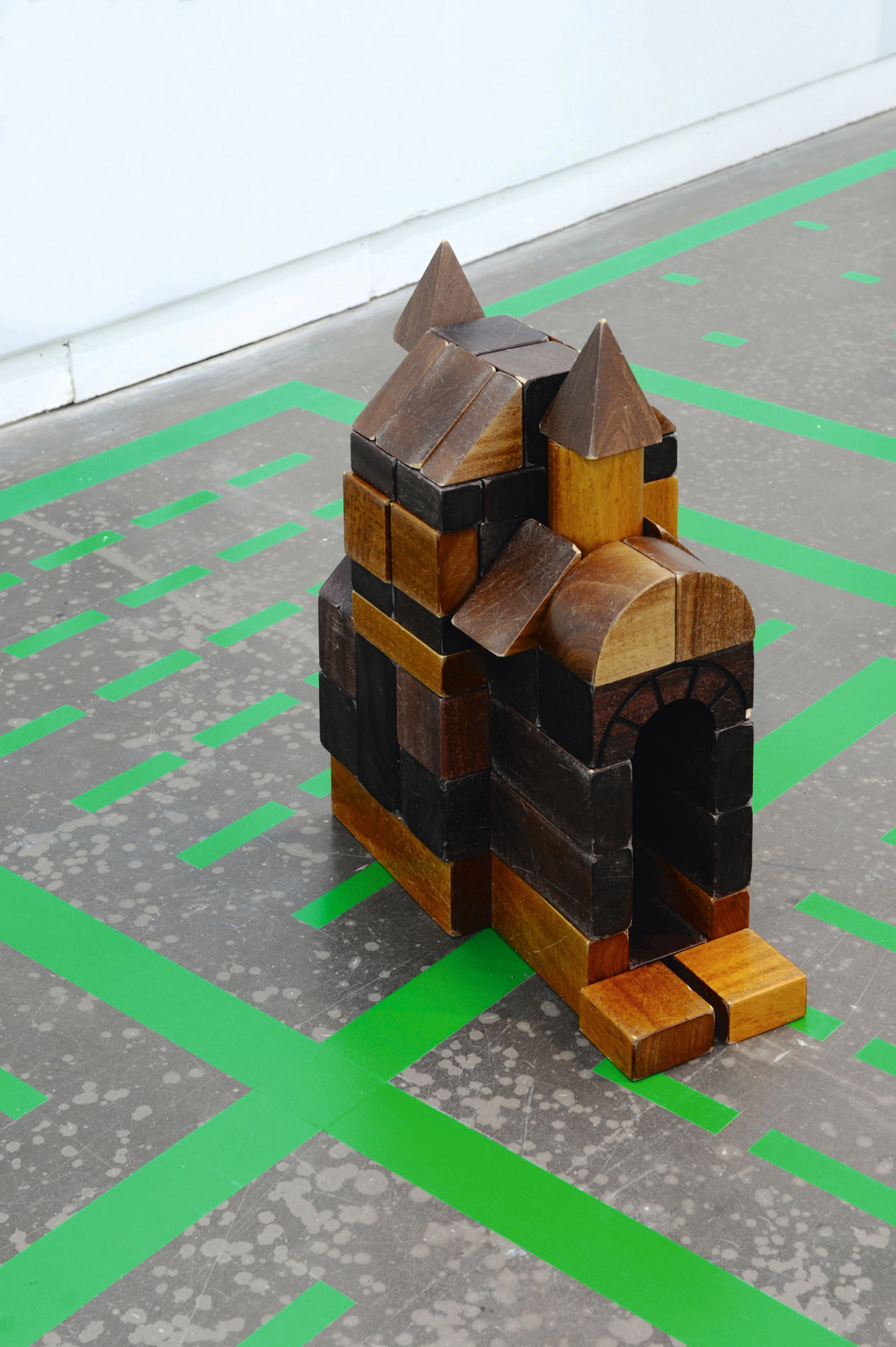
Social Construction, 2012, architectural toy set and posters (detail), ‘Rise Early, Be Industrious’, MK Gallery, Milton Keynes
Social Construction, 2012
architectural toy set and posters to assemble 31 different institutional structures
This work is based on the Anchor Stone Blocks, a popular learning game patented by Friedrich Richter in 1884. The game has a similar logic to a system developed by Friedrich Fröbel, the German nineteenth-century educational reformer and inventor of the kindergarten who advocated ‘free play’ in childhood. Unlike Fröbel’s version of the blocks, Social Construction is a ‘closed’ game, which educates players about the institutional structures that make up mainstream society. A limited number of building options are presented on posters papered to the walls, including a church, a school, a military academy, and even a cultural institution.

Set Sail for the Levant: A Board Game About Debt (or a Social Satire), 2007
printed board, cards, dice, lead counters, painted plastic figures, fake gold pieces
Set Sail for the Levant: A Board Game About Debt (or a Social Satire), 2007
The board game is a satire on English history. It tells the story of the enclosure of the commons when the countryside was privatised. Players are forced to seek their fortune by migrating from their rural homes to the industrial cities. But in this rigged game, there is only one way to win: set sail and colonise other lands. Through the game’s structure, my hope was that players would feel frustration at their limited choices – go into debt, resort to criminality, or become part of reproducing this system of exploitation elsewhere?
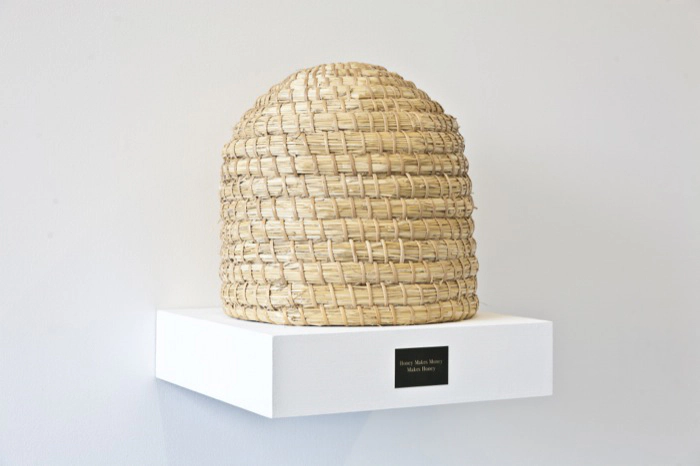
Honey Makes Money Makes Honey, 2012, wicker beehive, brass plaque
Honey Makes Money Makes Honey, 2012
wicker beehive, brass plaque
A wicker beehive (or skep) was representative of the perfect industrious society in the Victorian period. George Cruikshank famously used it in his satirical cartoon The British Beehive (1867), which appears elsewhere in the exhibition, to represent the economist Adam Smith’s idea of a hierarchically organised society in which there is a clear division of labour.

Words and Laws (whose shoulder to which wheel?), 2012, mixed-media installation, ‘Rise Early, Be Industrious’, MK Gallery, Milton Keynes

Stockholm Duck House: Proposed Monument to British Parliamentary Corruption, Circa 2009, 2012, architectural model
Stockholm Duck House: Proposed Monument to British Parliamentary Corruption, Circa 2009, 2012
architectural model of painted wood and lead, brass plaque
An image of the Stockholm Duck House was widely circulated in the British media in 2009, becoming the symbol of a corruption scandal, in which many British MPs were found to be fiddling their parliamentary expenses and claiming money for inappropriate items from the public purse. It was an aristocratic Conservative MP, Sir Peter Viggers, who famously claimed for the ‘Stockholm Duck House’. The structure, designed to provide protection for the birds, is based on an eighteenth-century building in Sweden. His expenses files reveal that British taxpayers also footed the bill for 28 tons of horse manure.

Empire City: The World on One Street, 2009
installation view with architectural model and video, ‘Rise Early, Be Industrious’, CCA, Glasgow

Empire City: The World on One Street, 2009, mixed-media model (detail)
The New Jerusalem, 2012, mixed-media installation and video
Filling the gallery are two architectural models that use display methods from the past in order to demonstrate the relationship between imperialism, trade and religion.
Empire City – The World on One Street (2009) represents the British Empire Exhibition, which took place in the West London suburb of Wembley in 1924. As an event, its purpose was to educate the public during their leisure time about Britain’s trading relationships with its colonies and bolster support for imperialism.
In 1924 the British Empire Exhibition was the largest exhibition that had been staged anywhere in the world, and the pavilions were piled high with theatrically displayed commodities, produced by countries that Britain ruled over. Human exhibits were also included, with over 60 West African people housed in 'native villages' in the pavilions representing Gold Coast (now Ghana), Nigeria and Sierra Leone. The model mixes the plan of the British Empire Exhibition with the fictional topography of John Bunyan’s widely read evangelical allegory The Pilgrim’s Progress (1678).

The Truth Itself Speaks Through Me, 2012, mixed-media model
O wretched man that I am, that I should sleep in the daytime!
—John Bunyan, The Pilgrim’s Progress (1678)
A second model titled The Truth Itself Speaks Through Me (2012) reveals the journey to the Celestial City recorded in The Pilgrim’s Progress. In the nineteenth century, this book was instrumental in educating the factory workers of the industrial revolution, illustrating the principle that the only route to paradise is through hard work.
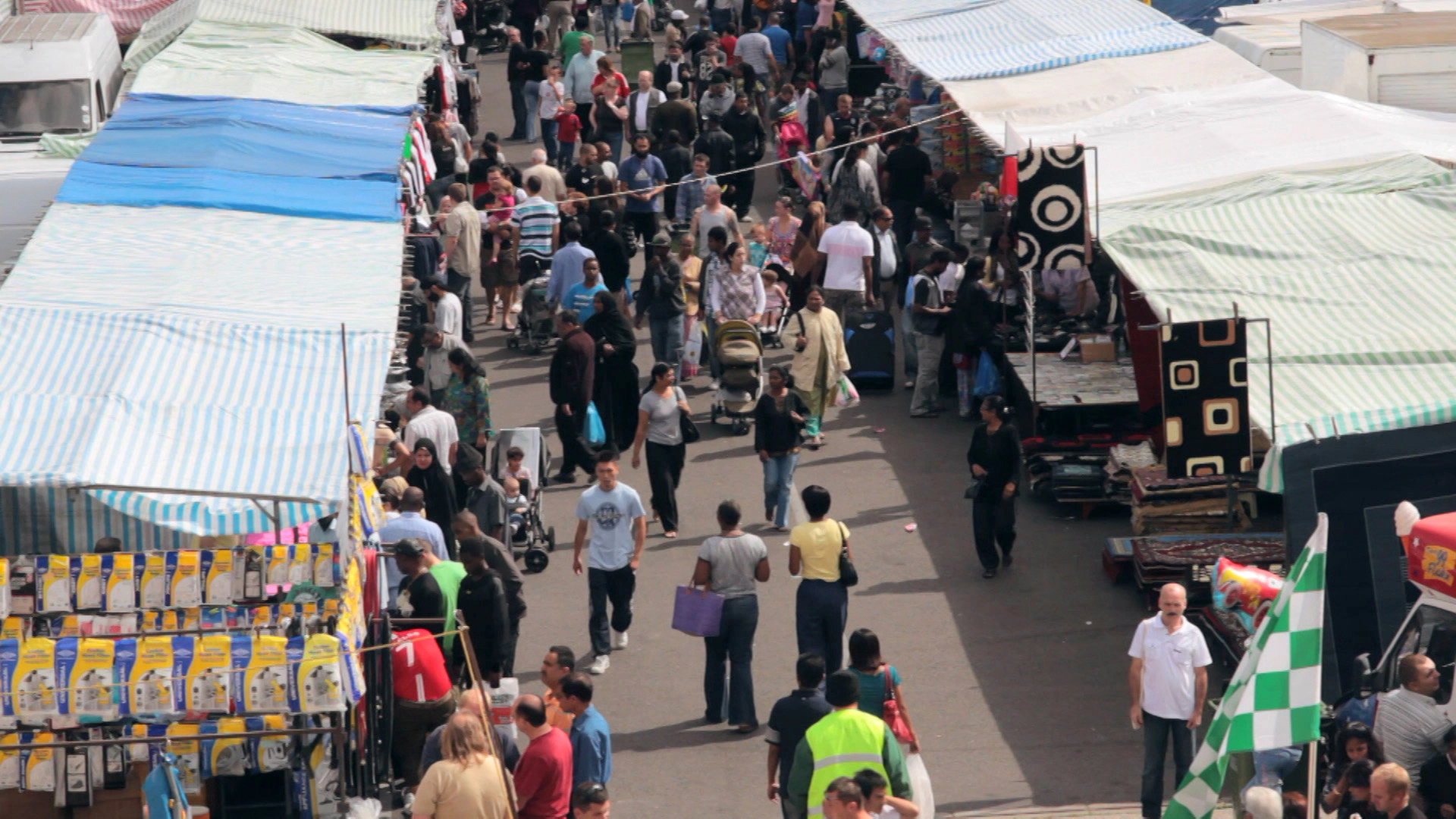
Market, 2009, video, 10 min. 9 sec., still
Market, 2009, video, 10 min. 9 sec.
Accompanying the models is a video titled Market, shot in a contemporary London street market in the shadow of Wembley Stadium. Next to the traders sits a red brick neighbourhood named the Empire Estate. In the 1920s, the British Empire Exhibition was the main engine behind the westward expansion of London and was used to advertise and promote new ways of living, suburban lifestyles in which ‘pioneers’ and their families were encouraged to settle in ‘colonies’ surrounding Wembley.
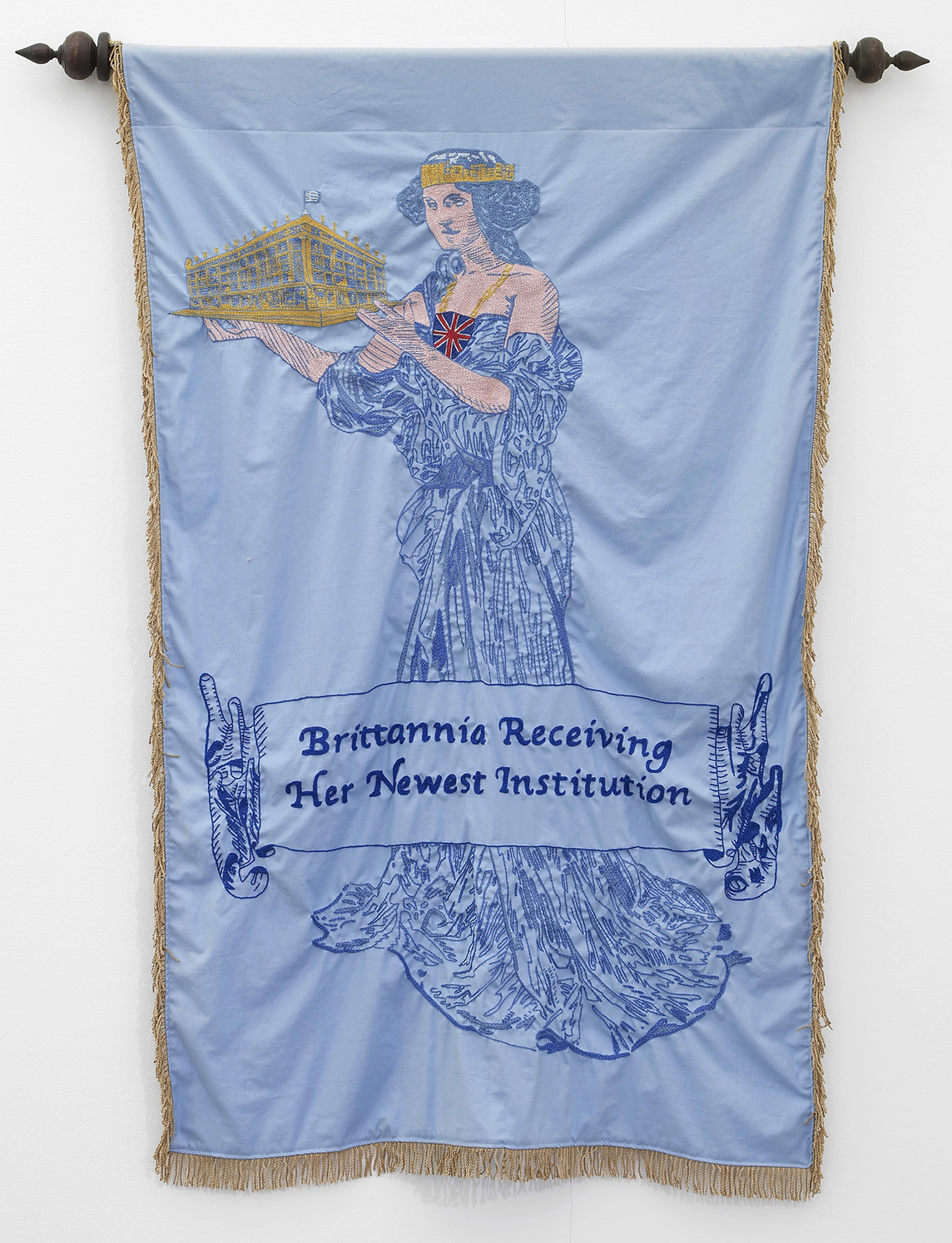
Britannia Receiving her Newest Institution, 2012, hand-embroidered fabric banner
Two fabric banners are included in the installation. In Britannia Receiving her Newest Institution, embroidered in the Arts and Crafts style, Britannia is seen holding a miniature version of the Selfridges department store in London. How Paul’s Penny Became a Pound is based on a joyless nineteenth-century book that taught British children about banking.
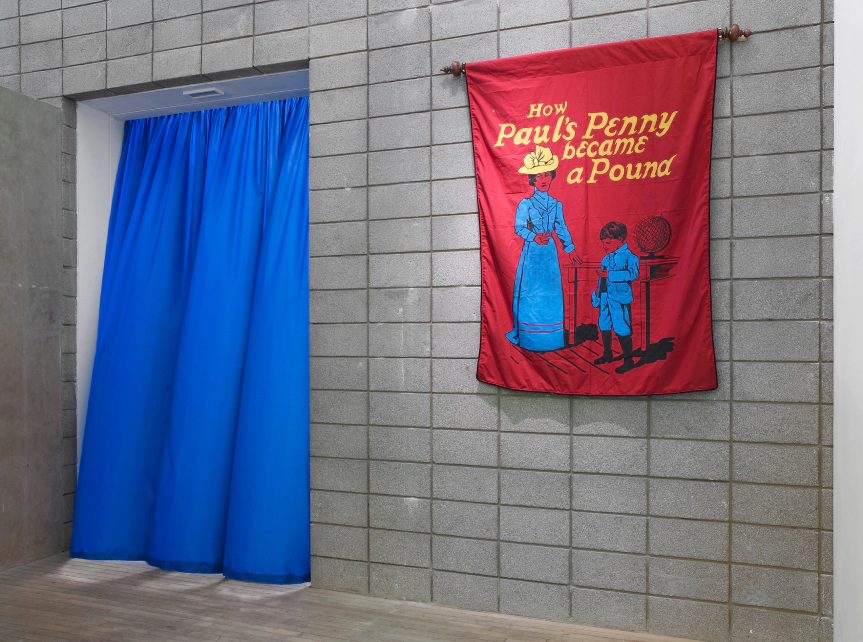
How Paul’s Penny Became a Pound, 2012, hand-painted fabric banner
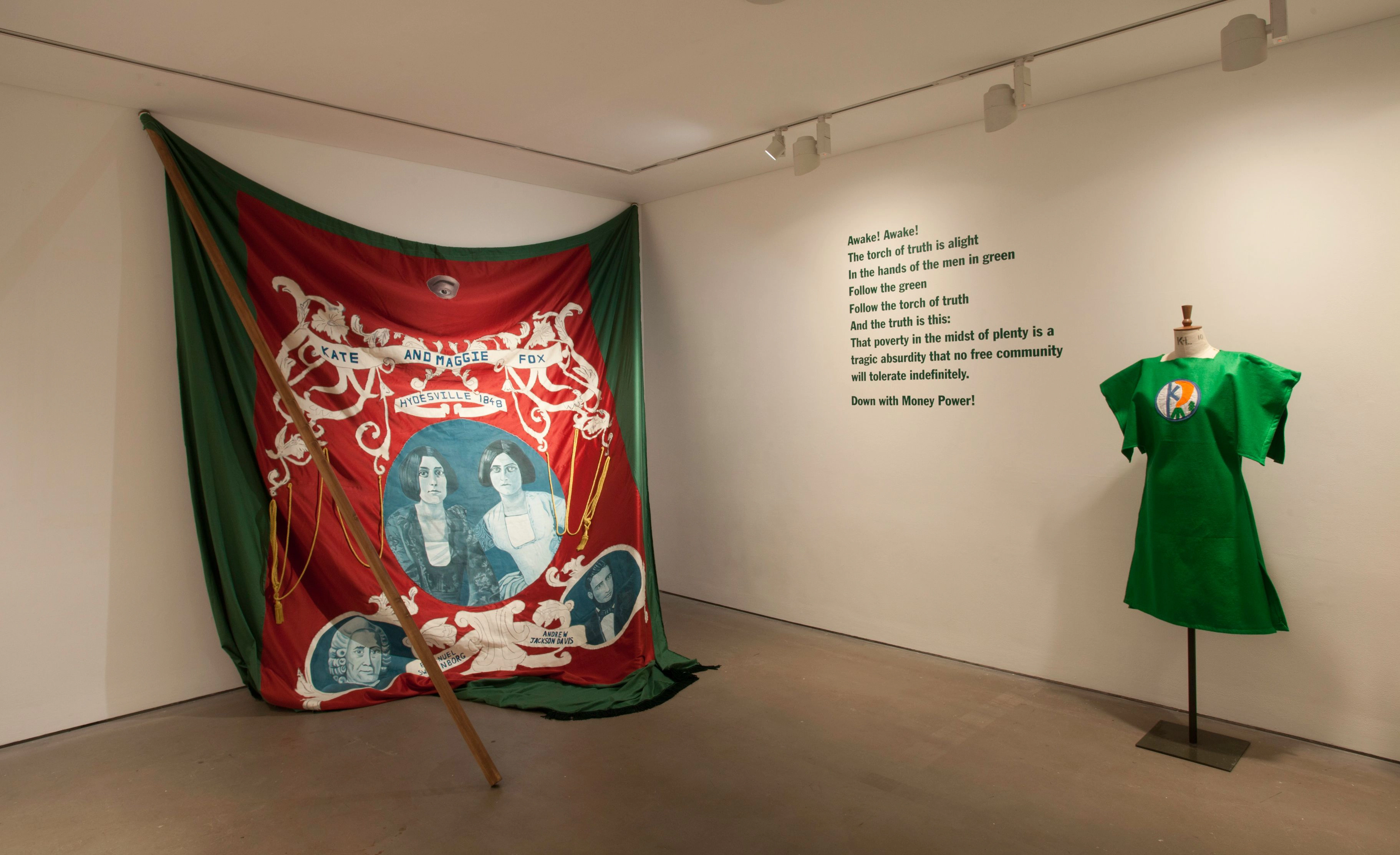
Regeneration, 2012, installation view at Arnolfini, Bristol, with fabric banner, fabric costumes, vinyl text, drawing
Regeneration, 2012
fabric banner, costumes, vinyl lettering, diorama
Regeneration comprises a small selection of works about two related utopian social movements that practised forms of mutual education: the Modern Spiritualist Movement and the Kindred of the Kibbo Kift. Emerging in the 1840s and the 1920s respectively, the roots of contemporary New Age ideas can be found in their combining of mysticism with the promise of liberation and colonial fantasies of the Other.
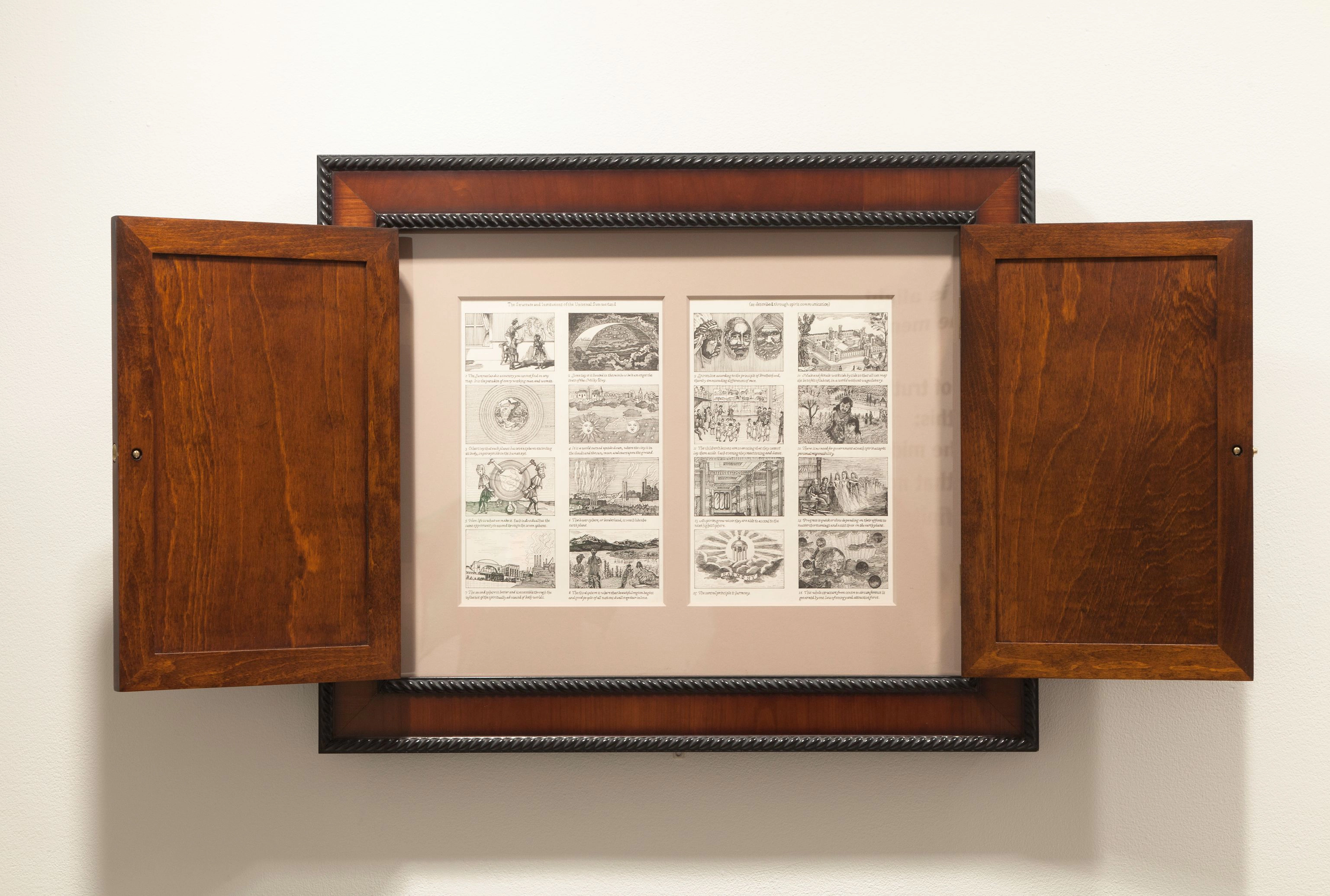
The Structures and Institutions of the Universal Summerland, 2007, framed ink on paper drawing
The Structures and Institutions of the Universal Summerland, 2007, framed ink on paper drawing
An elaborately framed drawing, from my graphic novel A Stellar Key to the Summerland, illustrates the progression up the social ladder that can be made in the afterlife – from slum dwelling to utopian socialism, as exemplified by illustrations of Charles Fourier’s phalanx and Robert Owen’s New Harmony.
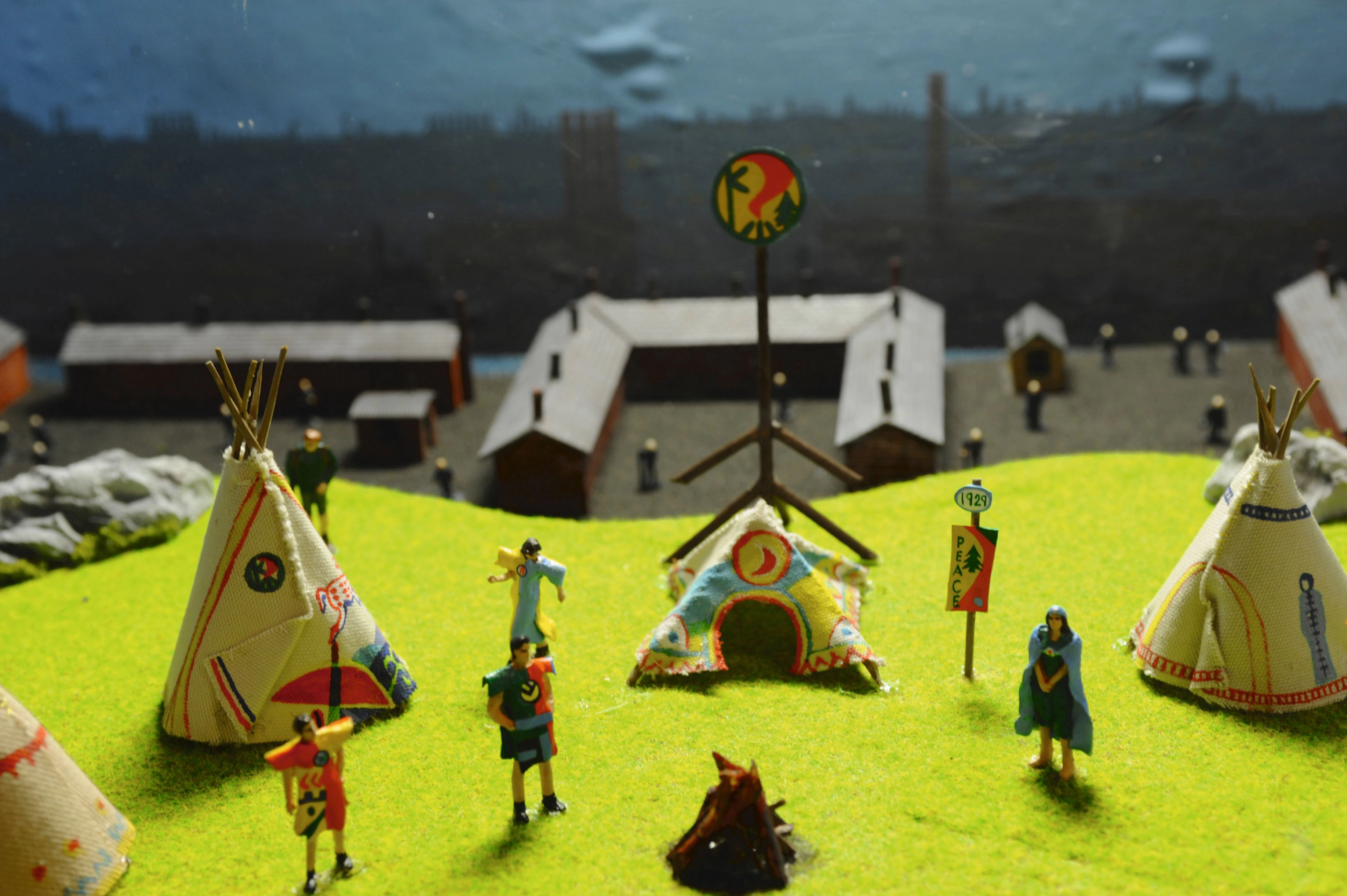
Machine Shall Be the Slave of Man, But We Will Not Slave for the Machine, 2009, diorama (detail)
Machine Shall Be the Slave of Man, But We Will Not Slave for the Machine, 2009, diorama
A diorama representing a Kibbo Kift camp, with an industrial city and smoke-belching factories in the background.
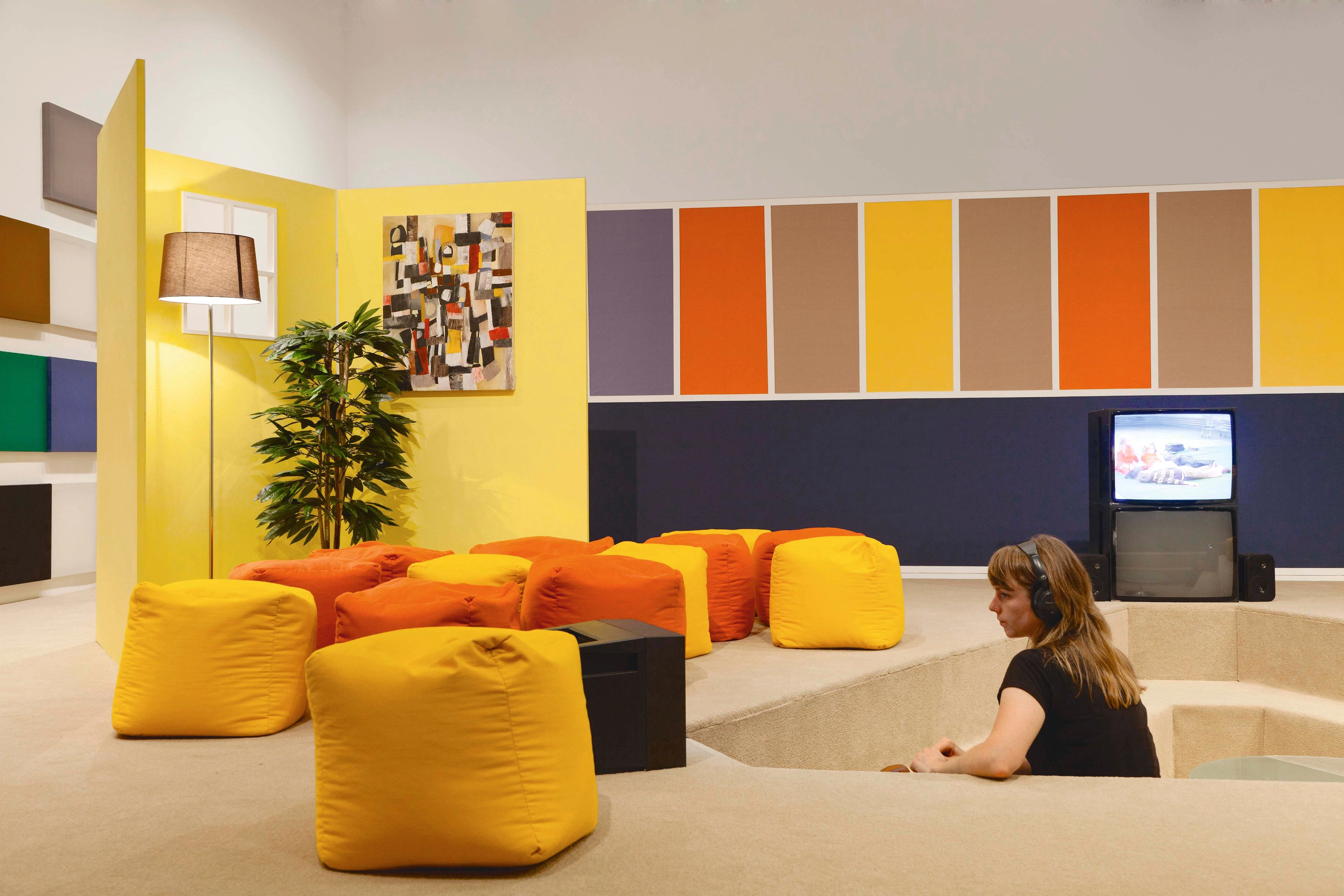
Open Forum, 2012, mixed-media installation (detail), ‘Rise Early, Be Industrious’, Arnolfini, Bristol
Open Forum, 2012, mixed-media installation
Open Forum is a re-creation of a 1970s style TV studio, complete with stage, audience ‘conversation pit’, television monitors and a world map. The installation contains archive material related to experimental art education in the UK, focusing on The Open University’s interdisciplinary Art and Environment course. Running from 1976 until 1985, the influential course’s chief agenda was to rethink the relation between art and society. Courses were offered for home study without entry requirements, and lectures were broadcast on BBC television and radio.

Open Forum, 2012, mixed-media installation (detail), ‘Rise Early, Be Industrious’, Arnolfini, Bristol
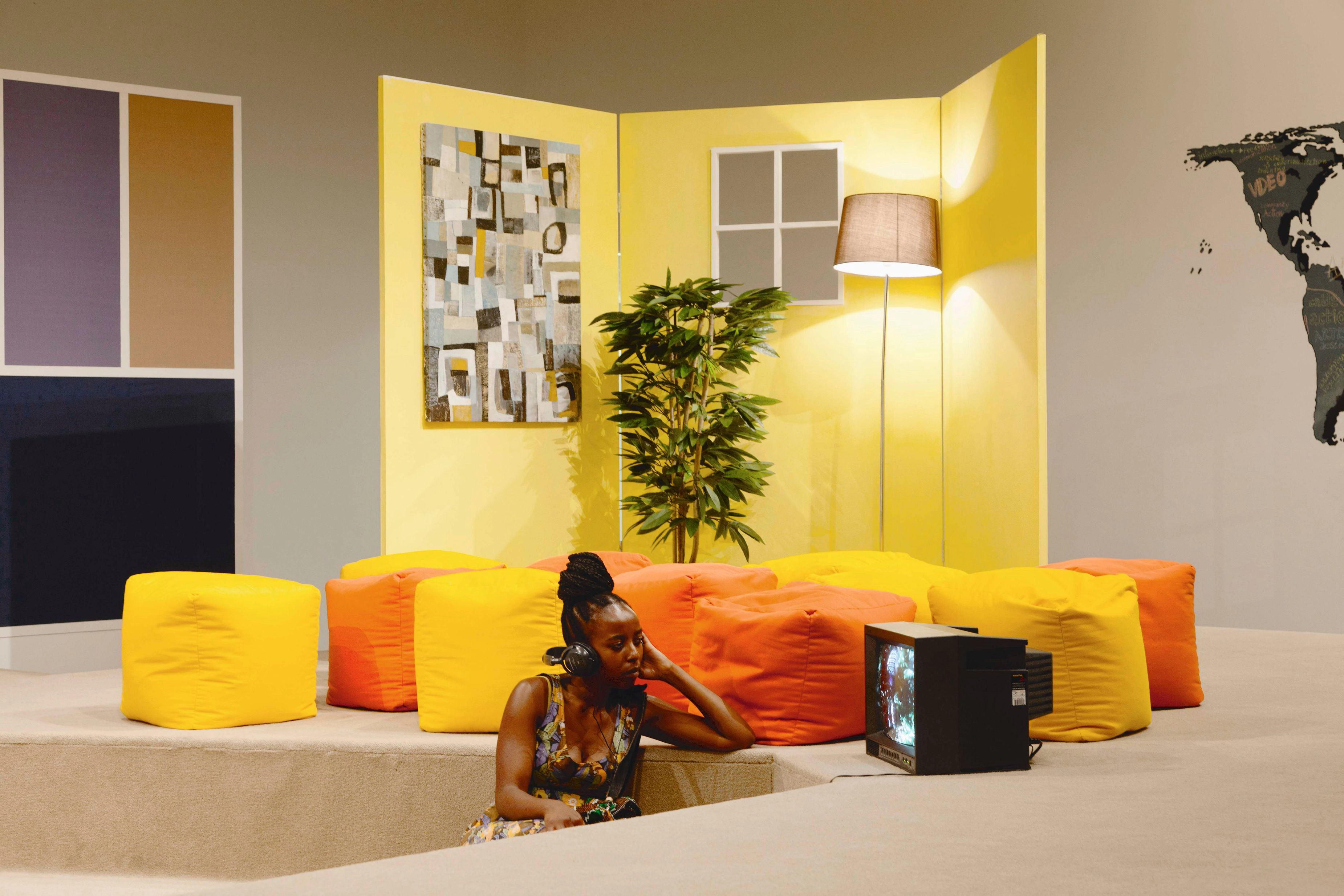
Open Forum, 2012, mixed-media installation (detail), ‘Rise Early, Be Industrious’, Arnolfini, Bristol
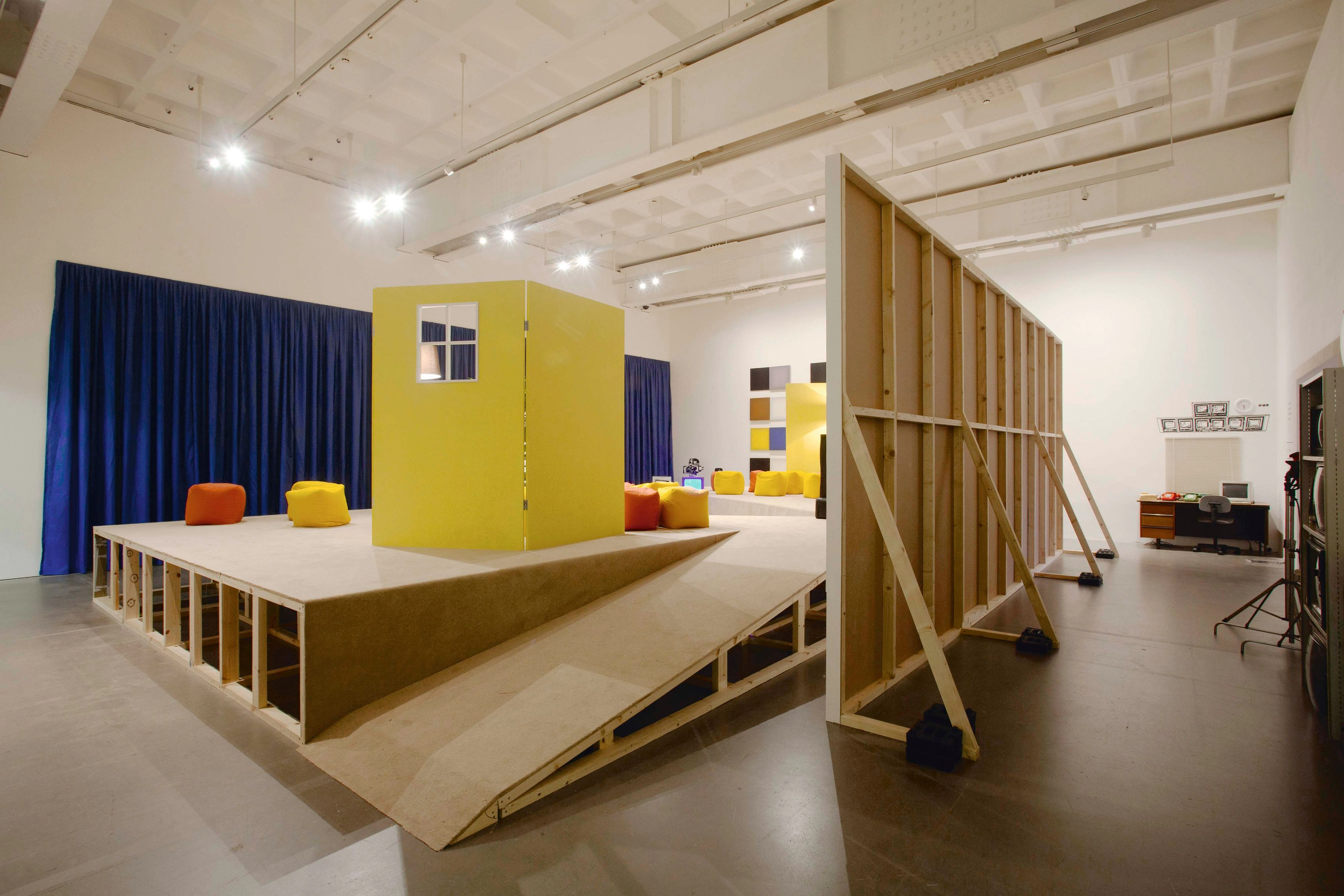
Open Forum, 2012, mixed-media installation (detail), ‘Rise Early, Be Industrious’, Arnolfini, Bristol
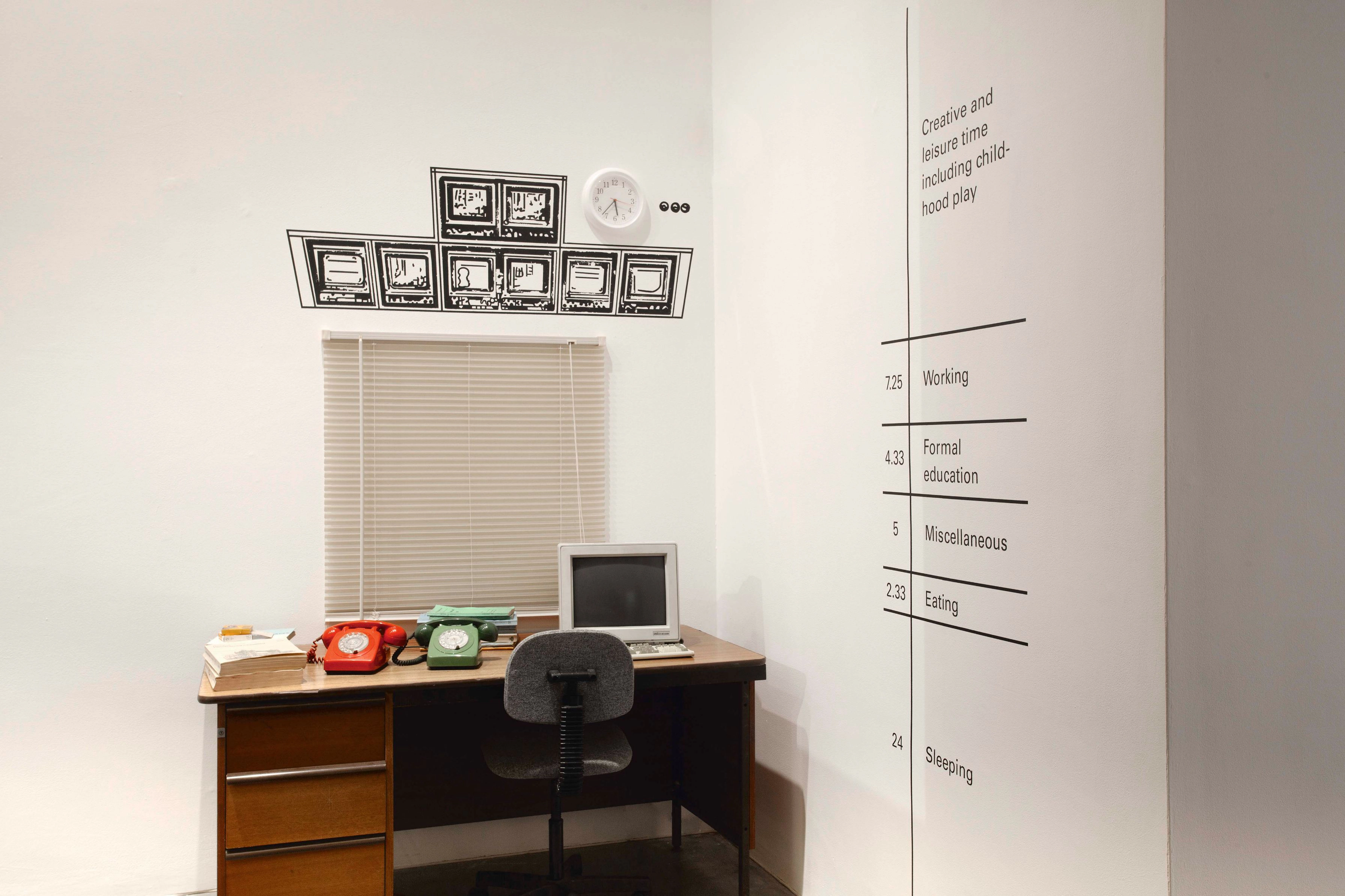
Open Forum, 2012, mixed-media installation (detail), ‘Rise Early, Be Industrious’, Arnolfini, Bristol
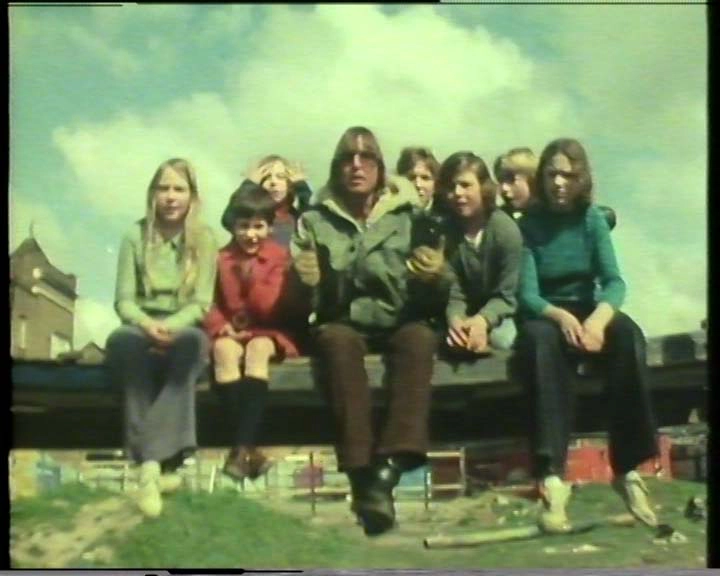
Whatever Will Be (1977), still from programme made by the Art and Environment course and the BBC
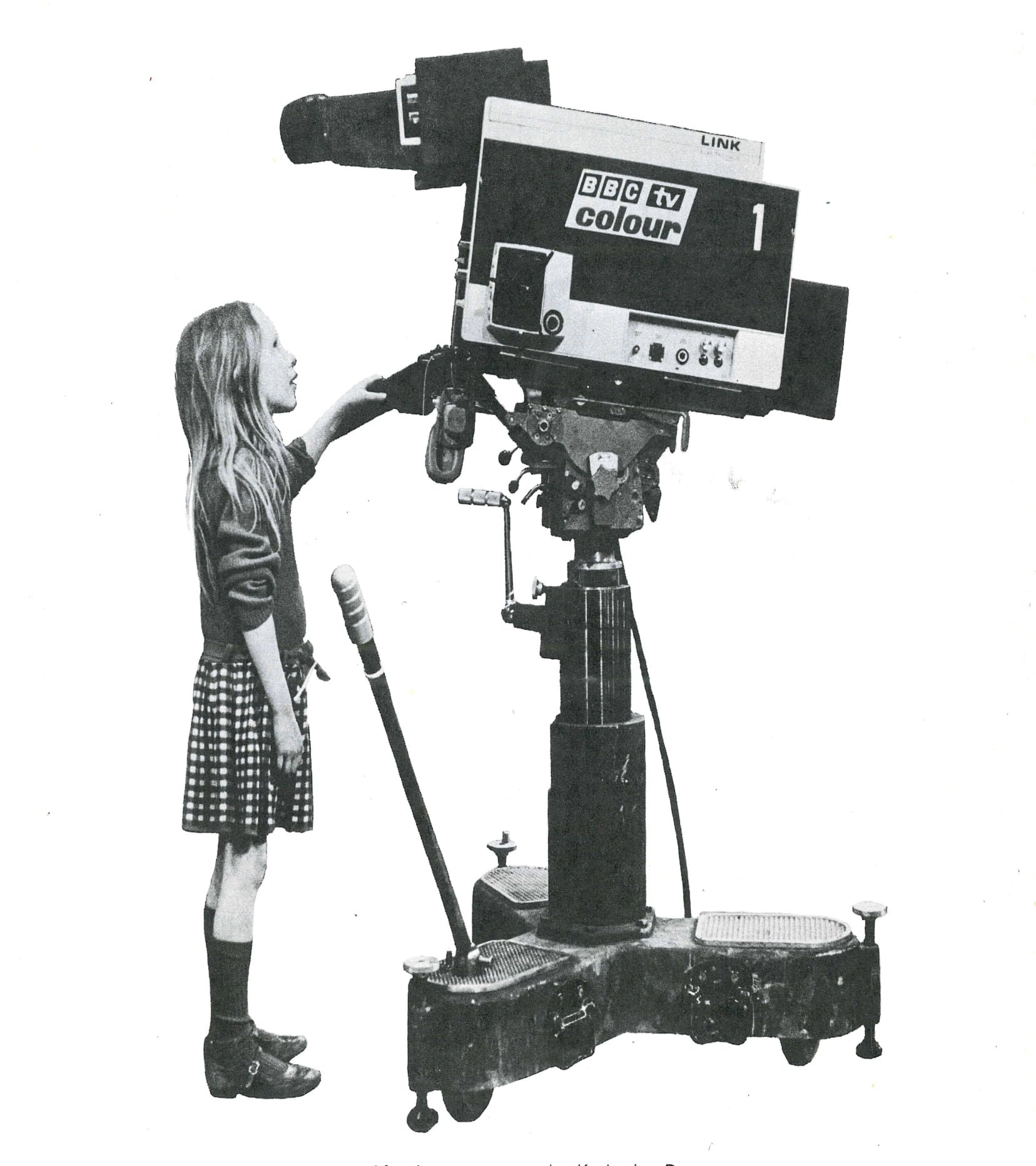
Children and Video (1976), detail from Art and Environment course book
Three programmes, produced as course material in collaboration with the BBC, were shown on monitors in the installation. In Children and Video (1976) young children, aged 7–9, work with light-weight video cameras and recorders to make their own episode. Play and Place (1976) demonstrates how children’s play evokes larger society and environment on a miniature scale. In Whatever Will Be (1977), futurologist James Dator analyses the modern world and suggests how it can be improved through alternative lifestyles, communes and adventure playgrounds.
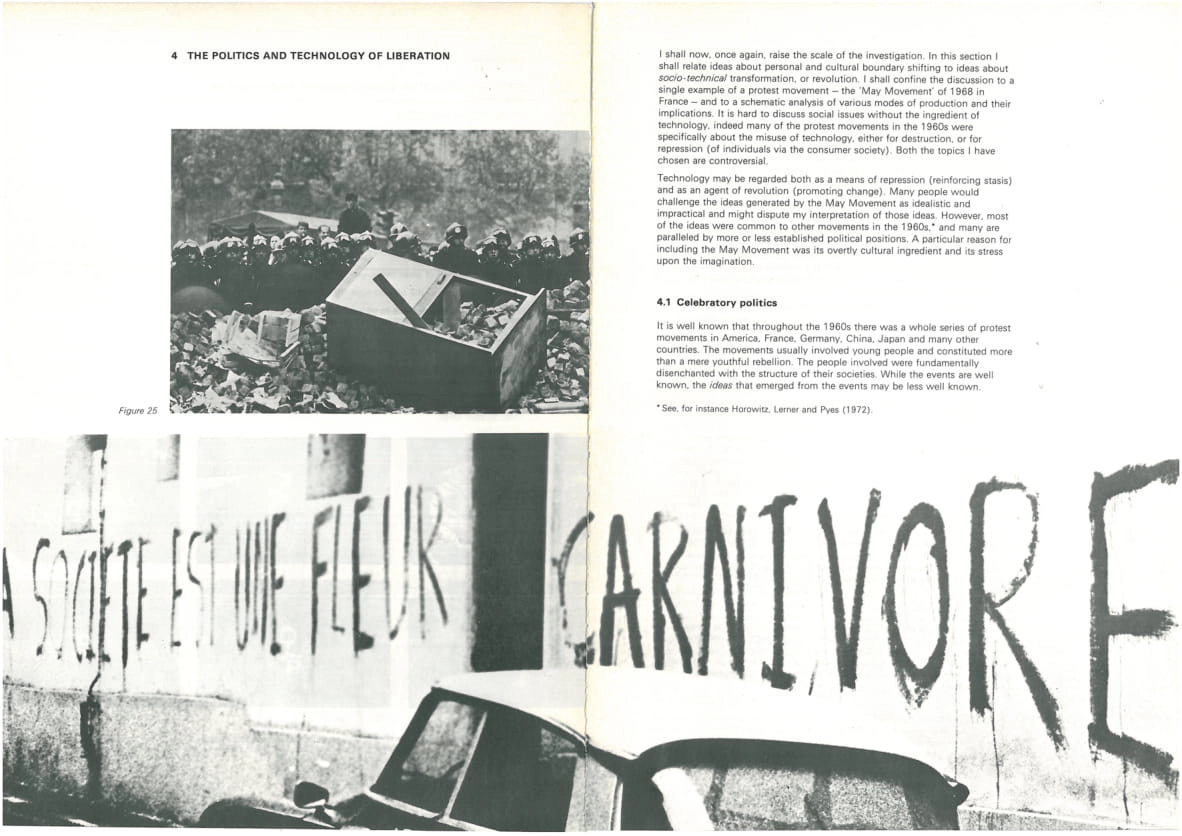
Art and Political Action (1976), Art and Environment course book (detail)
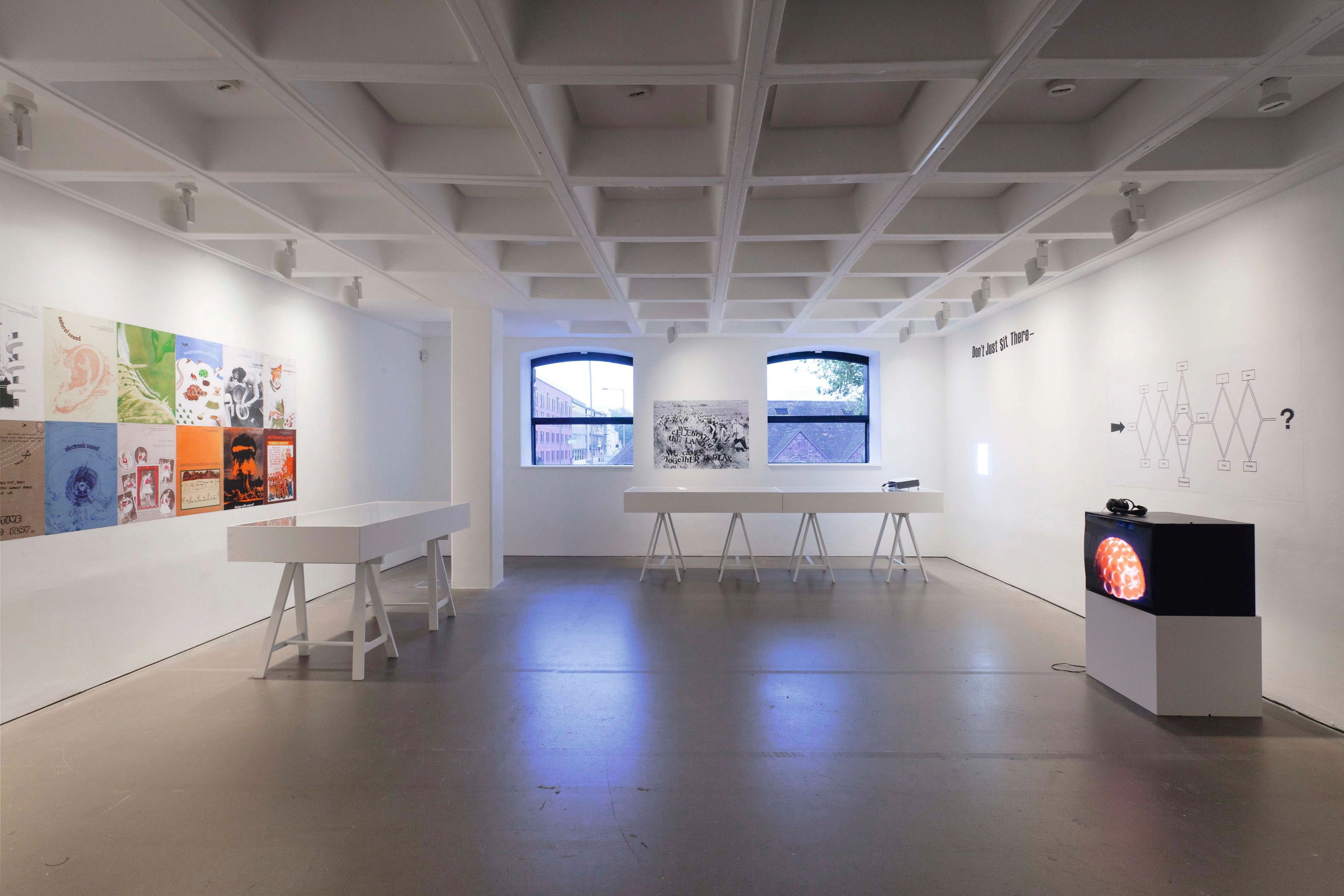
TAD 292, 2012, archival display, ‘Rise Early, Be Industrious’, Arnolfini, Bristol
TAD 292, 2012, archival display
As part of the exhibition I curated a display of archival material from The Open University’s interdisciplinary Art and Environment course which was officially titled ‘TAD 292’ (referring to Technology, Art and Design). The archival presentation comprised course material, including television programmes, letters, vinyl records, artworks, posters, course books and other printed matter.
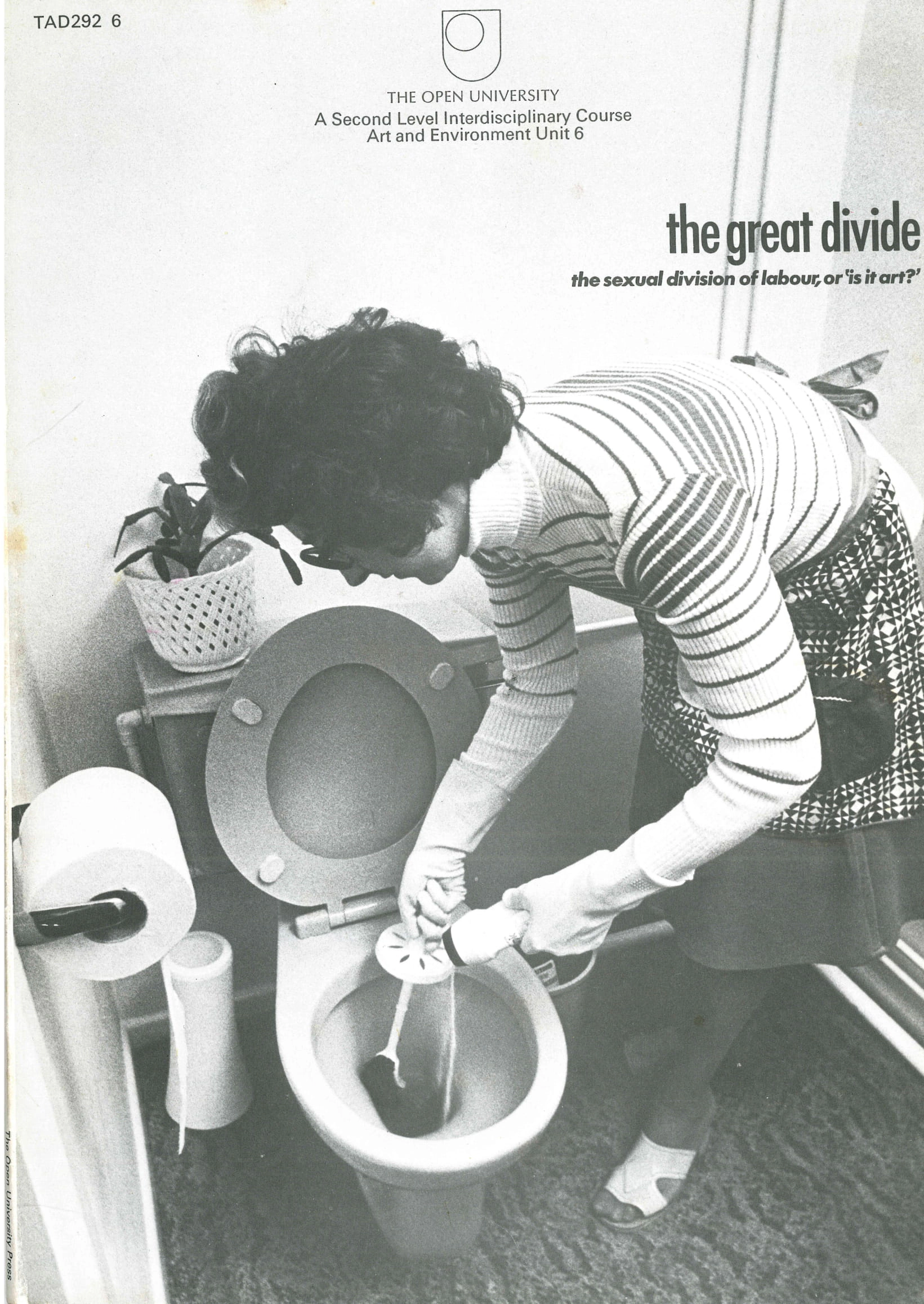
The Great Divide (1976), front cover of Art and Environment course book
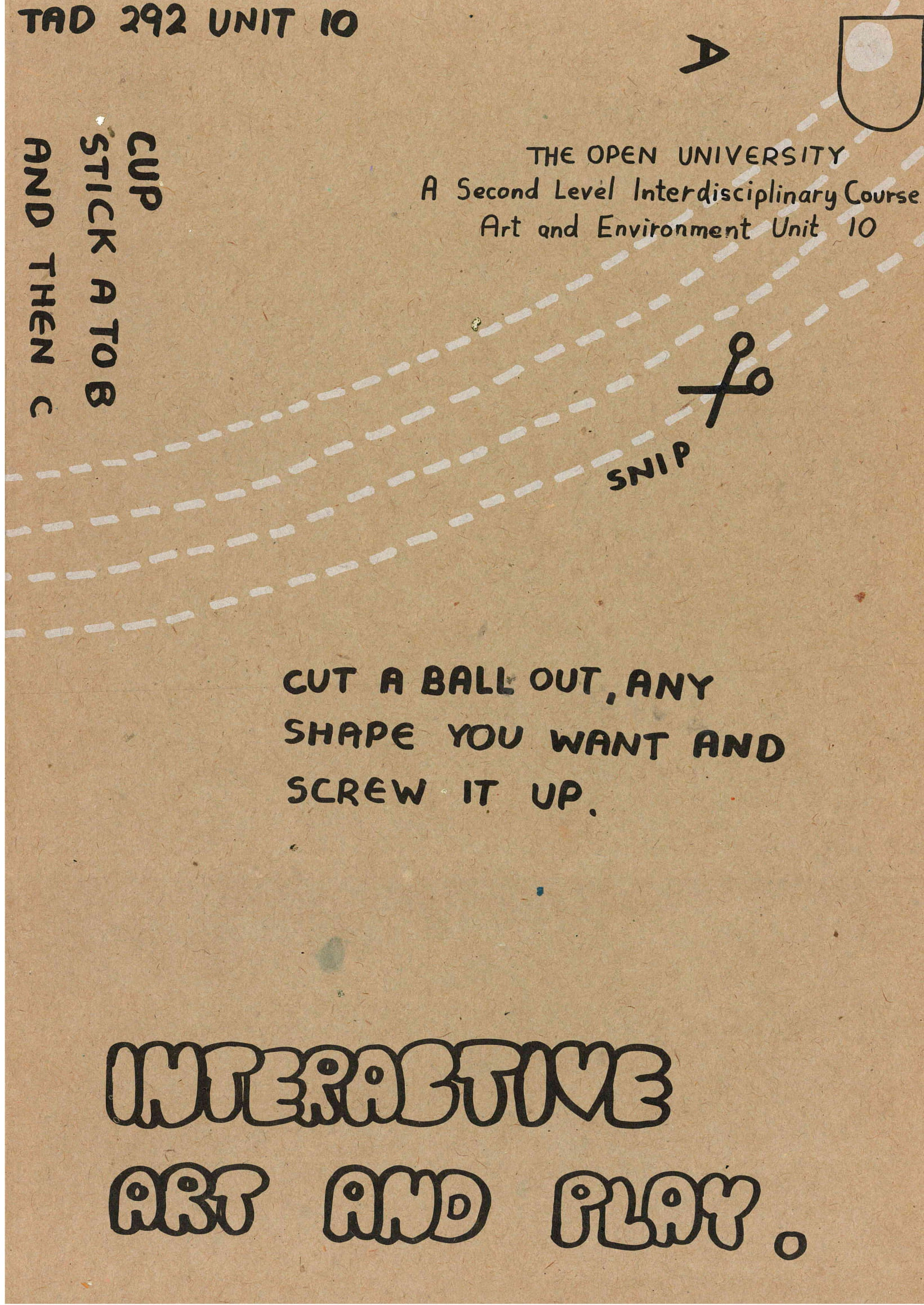
Interactive Art and Play (1976), front cover of Art and Environment course book
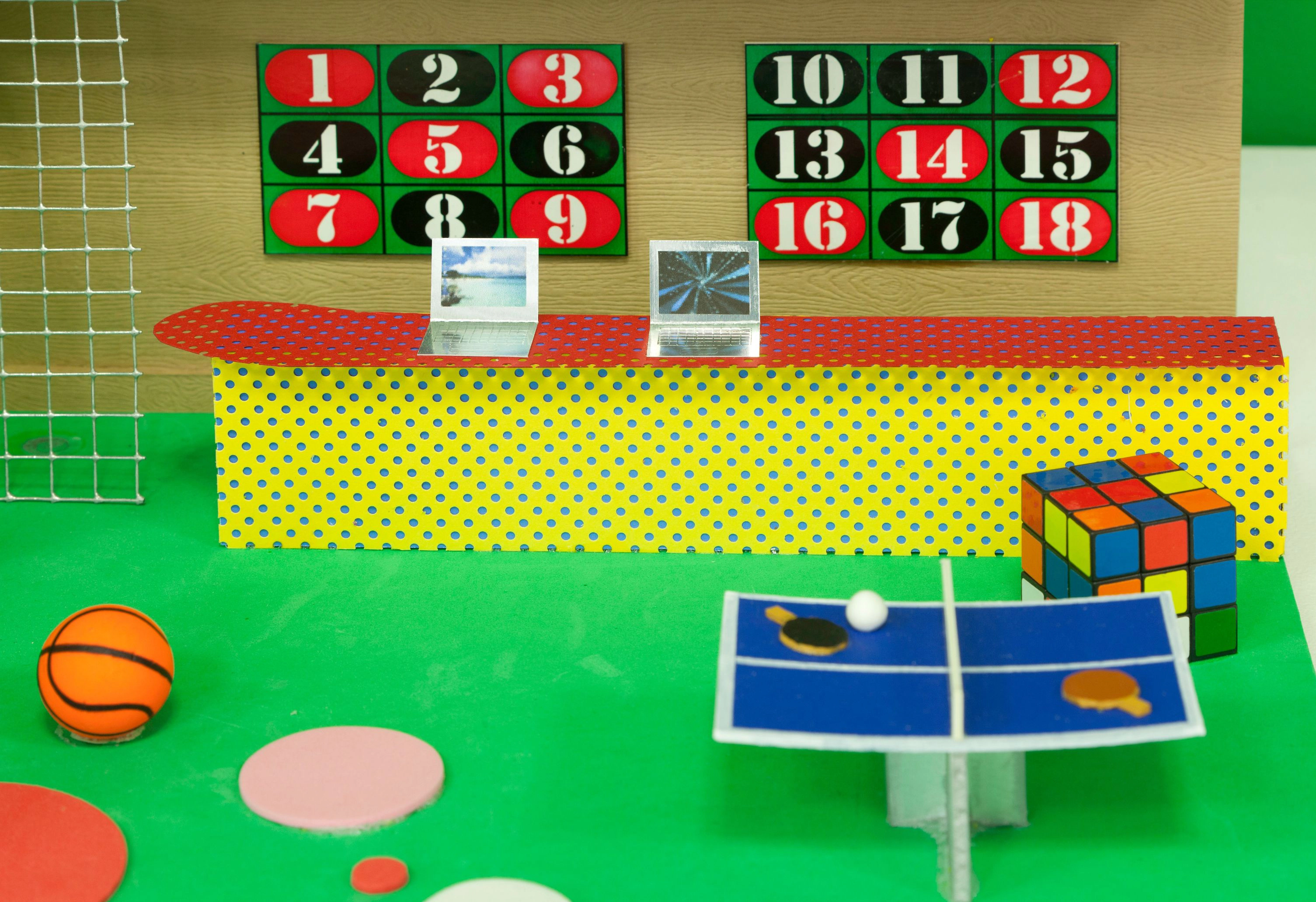
Proposal to Remodel Arnolfini (detail), 2012, architectural model of Arnolfini gallery
Proposal to Remodel Arnolfini, 2012
architectural model with paper, card and plastic elements
This is a satirical proposal to transform Arnolfini, Bristol – a public art institution – into a work space for freelancers from the creative industries. It takes the form of an architectural model of the building and explores how distinctions between work and leisure, public and private, are collapsed within the apparently playful workplaces characteristic of the post-Fordist economy. It highlights the demands placed on workers today to be entrepreneurial and self-reliant; individuals happily instrumentalising their creativity, striving for personal growth and self-actualisation while accepting less and less job security.
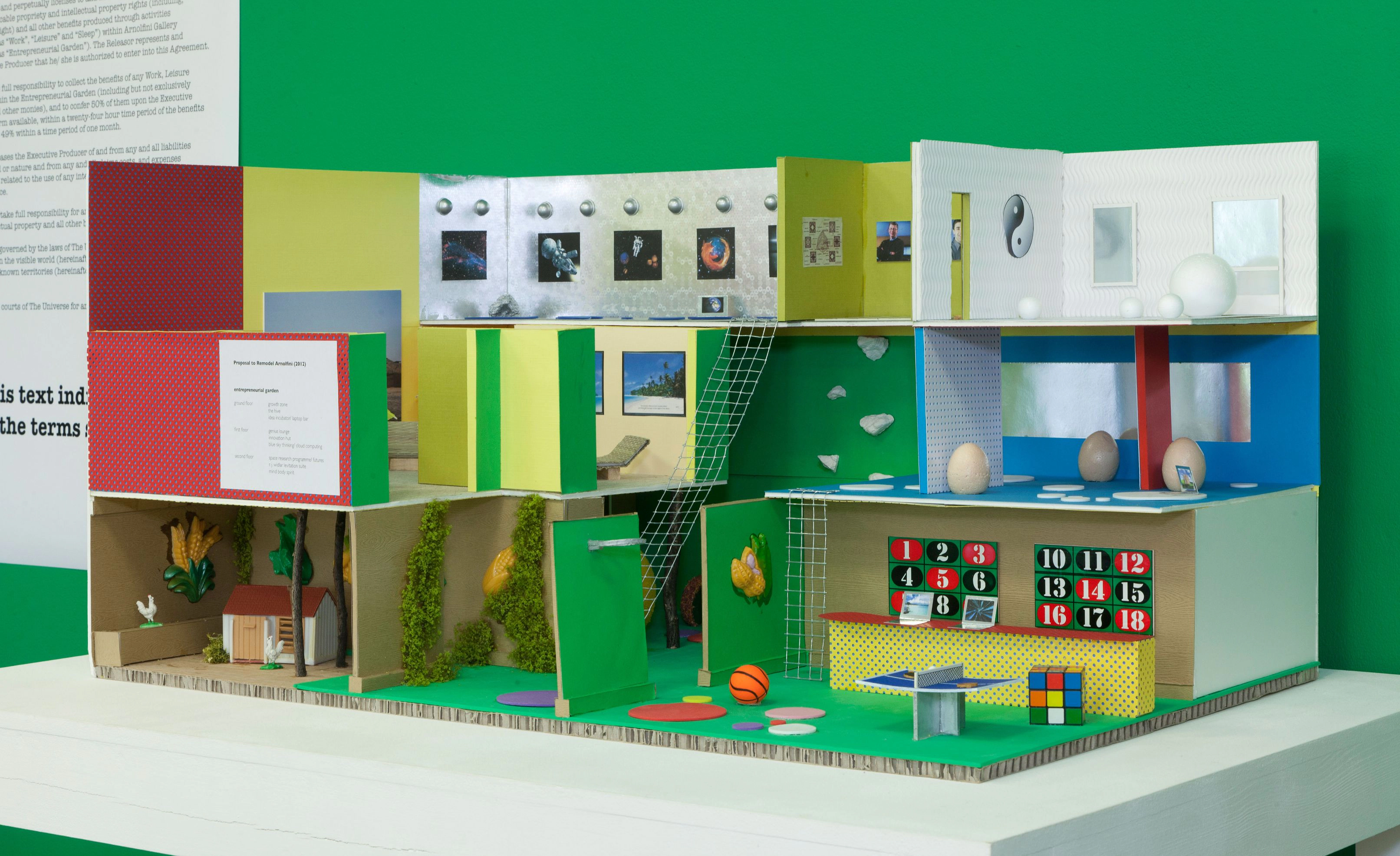
Proposal to Remodel Arnolfini, 2012, architectural model of Arnolfini gallery, ‘Rise Early, Be Industrious’, Arnolfini, Bristol
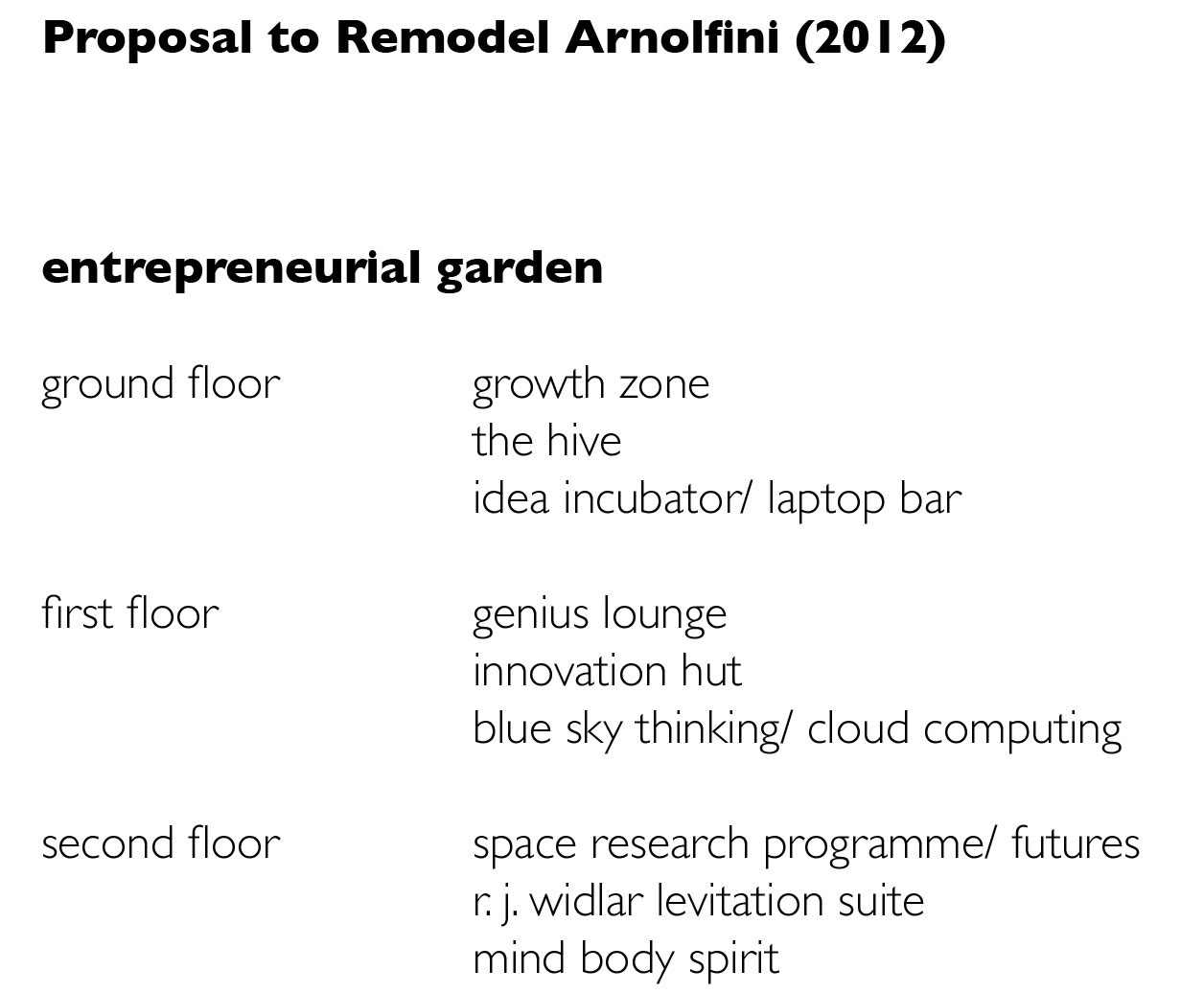
Proposal to Remodel Arnolfini (detail), 2012
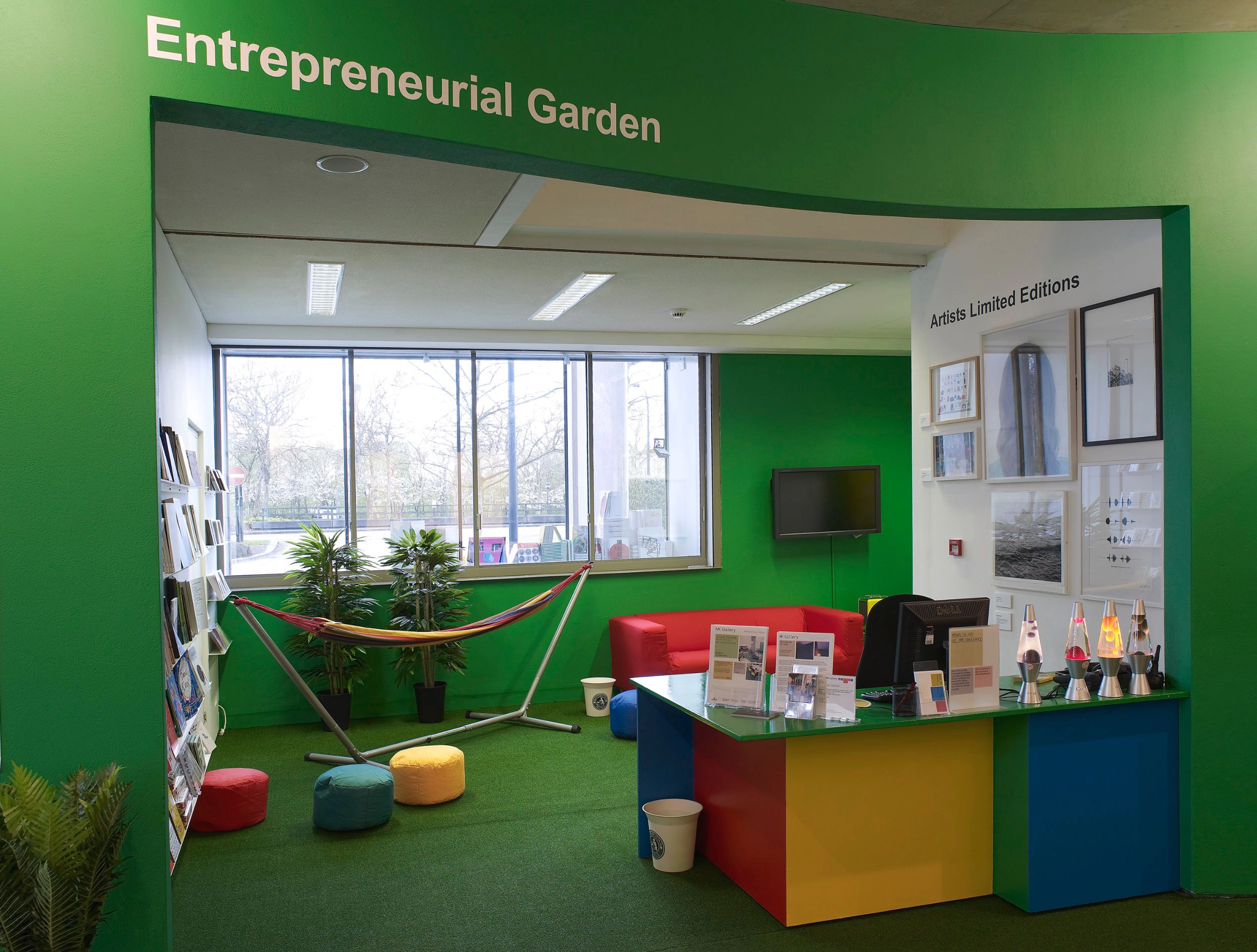
Entrepreneurial Garden, 2012, mixed-media installation, ‘Rise Early, Be Industrious’, MK Gallery
Entrepreneurial Garden, 2012, mixed-media installation
At MK Gallery, the foyer was transformed into Entrepreneurial Garden, a red, blue, green and yellow Google-style working environment. Visitors were encouraged to use the Entrepreneurial Garden which includes relaxed seating, a coffee machine, plants, table football and basketball hoop, along with motivational prints. An accompanying release agreement (paraphrasing those found on social media platforms) states that any intellectual property produced within the space becomes the property of MK Gallery, and that by reading the text, users of the space immediately indicate consent to its terms.
Resources
Olivia Plender interview about ‘Rise Early, Be Industrious’ at MK Gallery, Milton Keynes, 2012
(watch)Rise Early, Be Industrious, exhibition catalogue/artist’s book, published by Sternberg Press, 2016
(buy the book)Art Monthly review, Laura Allsop, September 2012
(download)‘Building Blocks as Tall as Buildings: Artists working with Early Child Pedagogy’, by Anna Craycroft, in ==#, edited by Matt Keegan, published by Capricious, 2015, featuring an interview with Olivia Plender
(download)==#, edited by Matt Keegan, published by Capricious, 2015
(view here)Set Sail for the Levant in the Tate Britain collection
(read more)